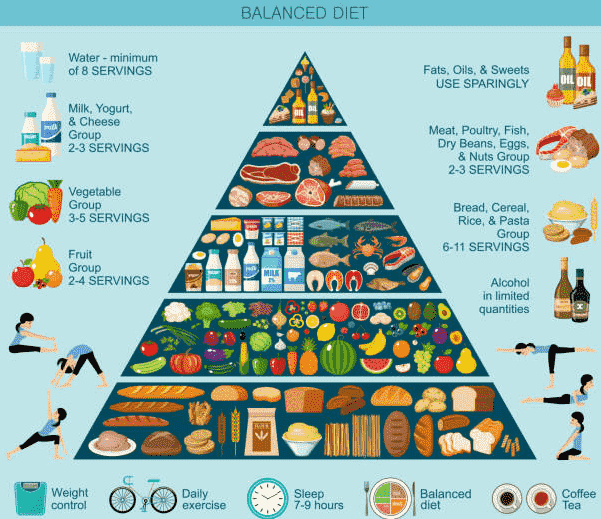Introduction:
A well-balanced diet plays a crucial role in supplying your body with a comprehensive spectrum of vital nutrients, ensuring that they are distributed in optimal proportions. The fundamental constituents of a wholesome and harmonious diet encompass:
- Protein
- Healthy fats
- Complex carbohydrates
- Vitamins
- Minerals
- Fiber
- Water
The classification of individual food items as inherently “good” or “bad” lacks nuance; what truly holds significance is the overarching equilibrium and judiciousness in consumption. Embracing a well-rounded dietary approach not only sustains energy levels but also facilitates growth, facilitates the mending of bodily functions, acts as a preventative measure against illnesses, aids in effective weight management, and offers an array of other multifaceted benefits.

Benefits of a Balanced Diet
Consistently incorporating a diverse and carefully curated range of foods into your diet offers numerous health benefits, some of which encompass:
- Stable energy levels
- Healthy body weight
- Improved gut health
- Enhanced immune function
- Lower disease risk
- Better mood regulation
- Healthy Aging
Furthermore, a well-balanced diet plays a pivotal role in fostering appropriate growth and developmental processes in both children and adolescents. This dietary approach not only ensures a sense of satiety and nourishment but also prevents excessive indulgence.
Key Components of a Balanced Diet
Protein
Lean proteins are rich sources of amino acids, essential for constructing vital elements such as muscles, bones, enzymes, and hormones within the body. You can obtain protein from:
- Poultry
- Fish and seafood
- Eggs
- Beans, lentils, peas
- Nuts and seeds
- Nonfat dairy
Carbohydrates
Carbohydrates constitute the primary source of energy for both the body and the brain. Prioritize nutrient-dense, complex carbohydrates obtained from:
- Fruits
- Starchy vegetables
- Whole grains like oats, quinoa, brown rice
Exercise caution and restraint in your consumption of added sugars and refined carbohydrates, steering clear of options such as sugary treats, white bread, and indulgent pastries that may compromise your nutritional goals and overall health.
Fats
Incorporating healthy fats into your diet not only furnishes your body with indispensable fatty acids but also facilitates the absorption of fat-soluble vitamins A, D, E, and K, contributing to your overall well-being. Opt for the enriching goodness of monounsaturated and polyunsaturated fats, found abundantly in:
- Olive oil
- Avocados
- Nuts and seeds
- Fatty fish like salmon
Limit saturated and trans fats found in processed foods.
Fruits and Vegetables
Indulge in the vibrant spectrum of fresh or frozen fruits and vegetables that not only dazzle the palate but also offer a myriad of health benefits. This colorful array serves as a bountiful source of dietary fiber, in addition to boasting an extensive array of essential vitamins, minerals, and potent antioxidants that collectively contribute to your overall well-being and vitality.
Calcium and Vitamin D
Low-fat dairy, leafy greens, soy milk, and fortified juice provide calcium for strong bones. Get vitamin D from sun exposure, fortified foods, and supplementation.
Hydration
Water is the quintessential life force that underpins the seamless orchestration of every bodily function, from the most intricate cellular processes to the broader systems that sustain our existence. Strive to maintain a well-hydrated state by setting a goal of consuming a recommended eight 8-ounce glasses of water each day. It’s important to recognize that the demands for hydration intensify when engaging in physical activities, emphasizing the crucial role of water in optimizing performance and ensuring the harmonious functioning of your body.
Achieving Balance with Meals and Snacks
Structure meals and snacks to include a balance of protein, smart carbs, and healthy fats. For example:
Breakfast:
- Oatmeal with almond milk, walnuts, and berries
Lunch:
- Turkey sandwich on whole grain bread with lettuce, tomato, and avocado
- Carrot sticks
Dinner:
- Baked salmon
- Brown rice
- Steamed broccoli
Snacks:
- Nonfat Greek yogurt with chopped fruit
- Hummus with veggie sticks
Allow yourself occasional treats in moderation. Pay attention to portion sizes as well. Balance is key for a healthy diet you can maintain lifelong.
Sample Balanced Weekly Meal Plan
Allow me to present a captivating illustration that unveils a week-long journey of culinary choices, seamlessly integrating all the facets of a nourishing and harmonious diet. Through this captivating example, you’ll witness the artful fusion of various food groups, guiding you toward a holistic approach to nutrition that spans the course of seven days.
Monday
Breakfast: Veggie omelet with whole-grain toast
Lunch: Grilled chicken salad
Dinner: Baked cod with quinoa and peas
Tuesday
Breakfast: Greek yogurt with berries and almonds
Lunch: Lentil vegetable soup
Dinner: Turkey tacos with salad
Wednesday
Breakfast: Peanut butter banana oatmeal
Lunch: Tuna salad sandwich on whole wheat
Dinner: Chicken stir fry with brown rice
Thursday
Breakfast: Cottage cheese with melon
Lunch: Whole wheat pita with hummus and veggies
Dinner: Grilled salmon with sweet potato
Friday
Breakfast: Nut granola with milk
Lunch: Brown rice sushi rolls
Dinner: Veggie pizza on whole wheat crust
Saturday
Breakfast: Veggie scramble with whole grain toast
Lunch: Black bean burger with sweet potato fries
Dinner: Chicken pasta primavera
Sunday
Breakfast: Overnight oats with chia seeds
Lunch: Butternut squash soup
Dinner: Veggie burritos on whole wheat tortillas
Tips for Creating a Balanced Diet
- Eat the rainbow – choose fruits and veggies of all different colors
- Read nutrition labels to be aware of portion sizes and nutrients
- Drink plenty of water throughout the day
- Limit sweets and fried foods
- Cook at home as often as possible
- Experiment with new healthy recipes
- Listen to your body’s hunger cues
Sticking with a balanced approach most of the time that allows room for flexibility and enjoyment is key for lifelong health. Geometry Dash
Some additional tips for achieving a balanced diet
Unlock a treasure trove of additional strategies, each brimming with ingenuity, to embark on the exhilarating voyage towards attaining a well-balanced diet that harmonizes with your lifestyle and nutritional aspirations.
- Vary your protein sources. Don’t just rely on meat for protein. Incorporate plant-based proteins like beans, lentils, tofu, edamame, nuts and seeds. This provides nutrient diversity.
- Focus on whole fruits over fruit juice. You get more fiber and nutrients from eating whole produce. Limit juice to a small glass per day.
- Go easy on condiments. Things like salad dressings, mayo, ketchup, barbeque sauce, and butter add a lot of calories, fat, and sodium. Use sparingly.
- Drink milk and water as your primary beverages. Skip sugary drinks like soda and limit juice. Milk and water are hydrating without extra sugar and calories.
- Always eat breakfast. Starting your day with a balanced meal helps stabilize blood sugar and hunger throughout the day.
- Learn proper portion sizes. Use measuring cups and read serving size info to be aware of how much you’re really eating. Moderation is key.
- Slow down at meals. Eating too fast often leads to overeating. Put your fork down between bites and focus on chewing thoroughly.
- Choose whole grains over refined grains. Options like oatmeal, brown rice, whole wheat pasta, and quinoa provide important fiber.
- Limit processed snack foods. Fresh fruits and veggies, unsalted nuts and seeds, plain yogurt, and hummus make healthier snacks.
- Don’t deprive yourself. Allow room for occasional treats. Just balance them with nutritious meals and smaller portions of sweets.



